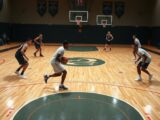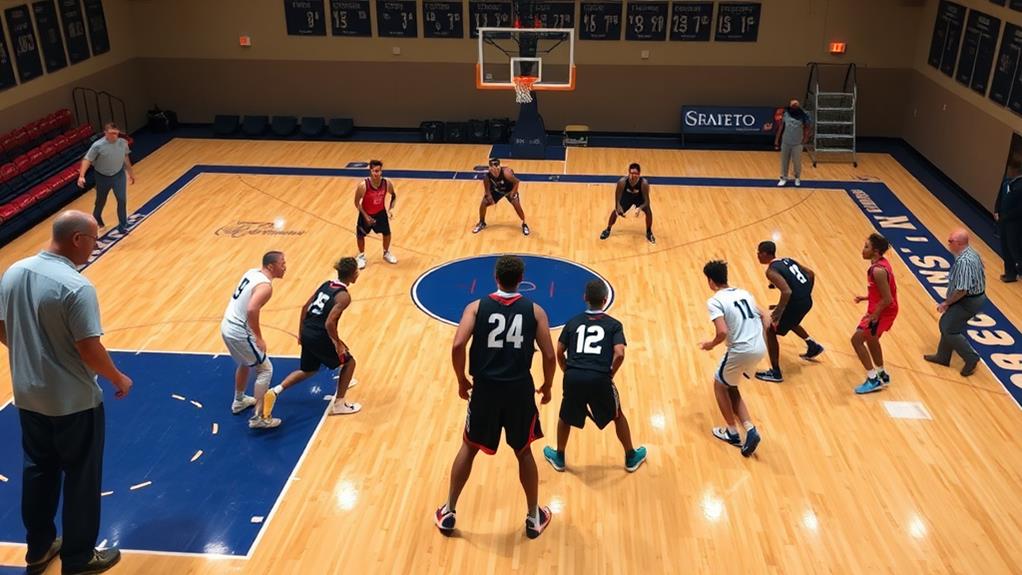
How to Implement the Princeton Offense in Basketball
October 2, 2024To implement the Princeton Offense in basketball, start with a focus on player movement and spacing. Maintain 12 to 15 feet between players to create driving lanes. Encourage quick ball movement with consistent passing and backdoor cuts. Utilize a strong high post player to facilitate plays. Prioritize teamwork and communication for better cohesion on the court. Train players to read defenses and adapt their movement accordingly. Incorporate drills for backdoor cuts and screening actions to build proficiency. With practice, this dynamic offense will enhance your team's scoring opportunities and overall effectiveness. Explore more techniques to maximize your team's potential.
Overview of the Princeton Offense
The Princeton Offense is a highly strategic basketball system that focuses on player movement and intelligent decision-making. Developed by Pete Carril at Princeton University, this offense emphasizes reading the defense and facilitating constant motion among players instead of following rigid patterns.
It primarily employs backdoor cuts, screens, and effective spacing to create high-percentage scoring opportunities against both man-to-man and zone defenses. By utilizing data-driven strategies, teams can optimize player roles within the Princeton Offense, ensuring that each player's strengths are effectively showcased.
In this system, players must have a high basketball IQ, as you'll need to make quick decisions based on defensive reactions. The offense often operates at a slower tempo, encouraging deliberate ball movement with multiple passes per possession. This not only exhausts defenders but also helps create mismatches.
Key components of the Princeton Offense include the Chin Series, Point Series, and Low Series, each designed to exploit defensive weaknesses through dynamic player movement.
Key Principles to Consider
When implementing the Princeton Offense, it's important to understand several key principles that drive its effectiveness. First, focus on reading the defense rather than sticking to rigid patterns. This flexibility allows you and your teammates to react to the defensive positioning, creating opportunities for scoring. As the game evolves, adapting to changes in evolving gameplay becomes essential for success.
Next, prioritize proper spacing. Players should maintain a distance of 12 to 15 feet apart to create driving lanes and open passing opportunities. This spacing is critical for effective ball movement, which keeps defenders off balance.
Continuous ball movement is necessary; quick passes and player cuts guarantee that the defense remains engaged and vulnerable. Additionally, a strong high post player is significant for facilitating the offense. This player helps set screens, make decisions, and distribute the ball effectively.
Team Requirements for Success
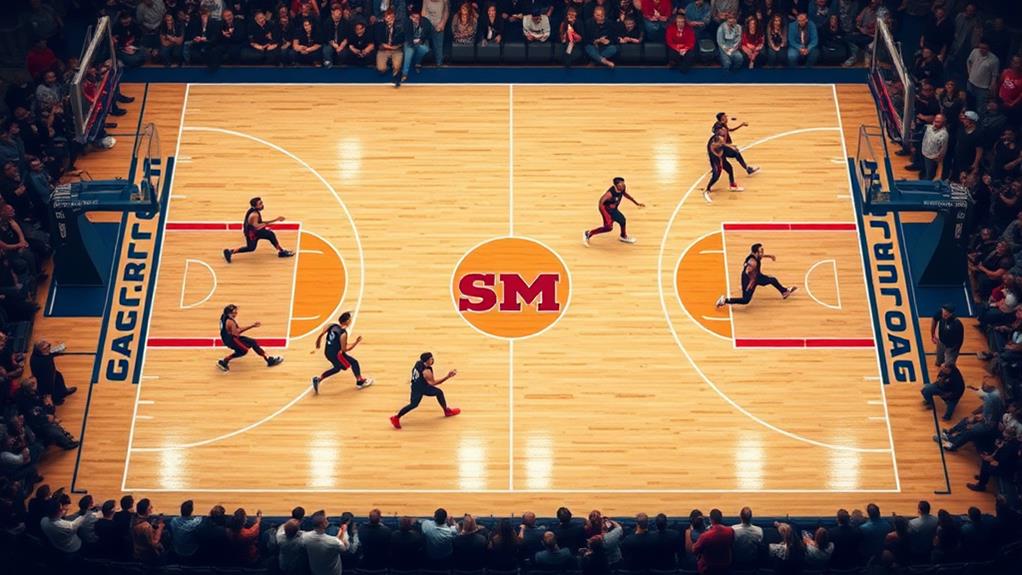
To successfully run the Princeton Offense, you need to focus on developing your players' skills and basketball IQ.
This offense requires players to have a strong understanding of teamwork and effective communication on the court, which can be enhanced through Inspiration Stories that highlight resilience and collaboration.
Each player should be able to pass, cut, and shoot effectively while also understanding how to read defenses quickly.
Emphasizing these aspects will create a cohesive unit capable of executing the offense efficiently.
Player Skill Development
Successful implementation of the Princeton Offense hinges on players' skill development, emphasizing the need for a high basketball IQ. To thrive in this system, you and your teammates must be skilled passers, ball-handlers, and shooters. Unselfish play and constant ball movement are key, so every player should focus on refining these skills.
Capable outside shooters are essential to prevent defensive sagging, which opens up driving lanes and enhances scoring opportunities. As you practice, work on your shooting range and accuracy to keep defenses honest.
A versatile big man in the high post plays a vital role; this player often acts as the playmaker, facilitating ball movement and creating passing options for teammates.
Emphasize developing your big man's skills in decision-making and passing to maximize effectiveness.
Basketball IQ Emphasis
A high basketball IQ is essential for every player in the Princeton Offense, as it empowers you to read defenses and make quick decisions on the fly. This approach demands that each player understands the flow of the game and anticipates defensive movements.
With a strong basketball IQ, you'll be better equipped to identify scoring options and exploit gaps in the defense.
Unselfish play is a cornerstone of the Princeton Offense. You must prioritize team success over personal statistics, creating a collaborative atmosphere on the court.
This mindset encourages effective ball movement, allowing players to make quick passes that keep the defense guessing and open up opportunities.
Continuous motion and adaptability are vital. You should always be ready to cut or set screens based on the defense's reaction, enhancing the overall offensive effectiveness.
A versatile skill set is also necessary; whether you're shooting, cutting, or making decisions, your ability to adapt will maximize the offense's potential.
Essential Player Skills
To excel in the Princeton Offense, you need a high basketball IQ that lets you read defenses and make quick decisions.
This requires an understanding of enhanced cultural exchange and understanding among teammates, as well as the ability to collaborate effectively.
Versatile skill sets are essential, allowing you to adapt to different positions and roles as the game unfolds.
Teamwork and unselfishness are critical, as this offense thrives on ball movement and creating opportunities for each other.
High Basketball IQ
Possessing a high basketball IQ is essential for players in the Princeton Offense, as it allows you to effectively read defenses and make quick decisions. You need to be aware of defensive positioning and movement, which helps you anticipate the best opportunities for your team. This awareness is vital when executing cuts and setting screens, as timing and spacing are key to creating open shots.
In the Princeton Offense, your passing skills are put to the test. Accurate and timely passing not only facilitates back-door cuts but also enhances dribble handoffs, generating scoring chances. Understanding how to space yourself—keeping 12 to 15 feet apart from teammates—prevents defensive congestion and opens up driving lanes.
Unselfishness is another critical component of a high basketball IQ. It's important to prioritize teamwork over individual scoring. By focusing on passing, you create opportunities for your teammates, fostering a more cohesive offensive flow.
Embrace these principles, and you'll find yourself thriving in the Princeton Offense, making smarter decisions that elevate your team's performance.
Versatile Skill Sets
Understanding the significance of a high basketball IQ naturally leads to recognizing the need for versatile skill sets in the Princeton Offense. Players must be able to adapt their game to various situations, as the offense thrives on fluid movement and quick decision-making.
As an offensive player, you need to be proficient in shooting, cutting, passing, and dribbling. This versatility is essential for maintaining offensive flow and capitalizing on scoring opportunities.
Your outside shooting ability is particularly important, as it stretches defenses and prevents them from sagging in the paint. When defenders respect your range, it opens up driving lanes for cuts and penetration, creating high-percentage shot opportunities.
Furthermore, you'll find that being a skilled passer and ball-handler is imperative in this offense; the constant movement demands quick ball distribution to exploit defensive lapses.
If your team lacks well-rounded players, especially in the high post and perimeter roles, you may struggle to implement the Princeton Offense effectively.
Emphasizing the development of versatile skill sets won't only enhance your individual game but also strengthen your team's overall performance.
Teamwork and Unselfishness
Emphasizing teamwork and unselfishness is essential when implementing the Princeton Offense. This system requires players to prioritize team success over individual scoring, fostering an environment where collaboration thrives.
To excel, you and your teammates need to exhibit a high basketball IQ, enabling quick, smart decisions while reading defenses. Continuous ball movement is imperative; stagnant play can lead to missed scoring opportunities.
You'll want to encourage each other to actively participate in the offense, making it a shared responsibility. Effective execution hinges on your ability as skilled passers and cutters. Successful backdoor cuts and give-and-go opportunities require precise teamwork, so practice these skills together.
Moreover, unselfishness is essential, as every player must contribute to both scoring and playmaking. This shared approach enhances overall team cohesion, creating a fluid dynamic on the court.
When players are willing to make sacrifices for the benefit of the team, it cultivates an atmosphere of trust and support. Remember, the goal is to create an offense that capitalizes on the strengths of all players, ensuring everyone feels involved and valued.
Embrace teamwork, and you'll see the Princeton Offense flourish!
Strengths of the Offense
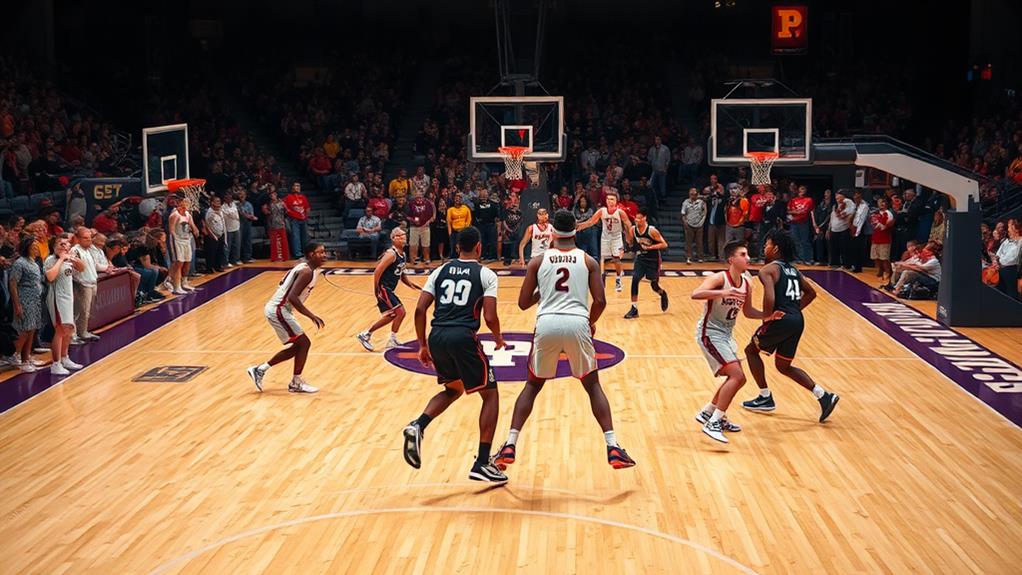
The Princeton Offense stands out for its ability to create numerous scoring opportunities through constant movement and teamwork. This system thrives on effective ball movement, making it challenging for defenses to keep track of players. With players constantly moving and positioning themselves, you can exploit defensive overplays, particularly through backdoor cuts that lead to high-percentage shots. Additionally, mastering technical skills such as ball control and shooting techniques can enhance individual contributions to this offense.
One of the key strengths of the Princeton Offense is its versatility. By encouraging all players to act as passers and scorers, you cultivate a positionless style that enhances adaptability and decision-making on the court. This versatility also allows the offense to excel against both man-to-man and zone defenses, employing quick hitters and varied series to generate open shots and mismatches.
Moreover, the culture of unselfish play fosters collaboration among teammates, which improves overall team cohesion. This unselfishness translates into better offensive efficiency, as players find the best scoring opportunities rather than forcing shots.
Ultimately, the Princeton Offense not only increases scoring potential but also creates a dynamic environment where teamwork and strategy flourish. Embrace these strengths, and watch your team elevate its performance.
Challenges and Considerations
When you implement the Princeton Offense, you'll quickly notice the learning curve for your players. They need to grasp complex concepts like spacing and timing to execute the system effectively.
To maintain enthusiasm and focus during this process, consider incorporating enjoyable practice drills that keep your players engaged.
Without a solid understanding and commitment, you risk disrupting the flow of the game and missing scoring opportunities.
Learning Curve Factors
Although mastering the Princeton Offense can be rewarding, players often face significant challenges due to its intricate nature. The learning curve is steep, as you'll need to grasp various movements, reads, and options that can feel overwhelming at first. Developing a high basketball IQ is vital; you must learn to read defenses and make quick decisions during fast-paced game situations. This might take time and practice, so be patient with yourself.
Players accustomed to faster-paced offenses may find it difficult to adjust to the slower tempo and deliberate ball movement emphasized in the Princeton system. Effective spacing and timing on cuts are essential for successful offensive execution. If you don't understand these concepts, it can lead to confusion and poor performance on the court.
If you're adapting from a traditional offensive system, you might struggle to adjust to the unorthodox structure and collaborative nature of the Princeton Offense. Recognizing that this change requires extra time will help you stay focused on improving your skills and understanding of the system.
Embrace the learning process, and you'll see your game elevate to new heights.
Spacing and Timing Issues
Effective spacing and timing are significant components of the Princeton Offense, as failure to maintain proper distance can lead to a breakdown in offensive flow. To guarantee success, you'll need to focus on several key areas:
- Maintain Distance: Players should stay 12 to 15 feet apart to create driving lanes and passing options. This spacing is essential for effective cuts and movement.
- Constant Movement: Players must continuously move to avoid congestion in the key area. Poor spacing can hinder offensive actions and make it challenging to execute screens.
- Synchronize Cuts: Timing is critical; players need to coordinate their cuts and movements. Delays can disrupt the flow and allow defenders to recover.
- Patience Under Pressure: Be aware of the shot clock. Rushing decisions can lead to missed opportunities and poor spacing, undermining the offense's effectiveness.
Transitioning players may find the Princeton Offense's unorthodox structure challenging.
With practice, they'll adapt to the constant movement and spacing demands that distinguish this offense from traditional systems. Emphasizing these elements will help you optimize spacing and timing for better offensive execution.
Setup and Formation
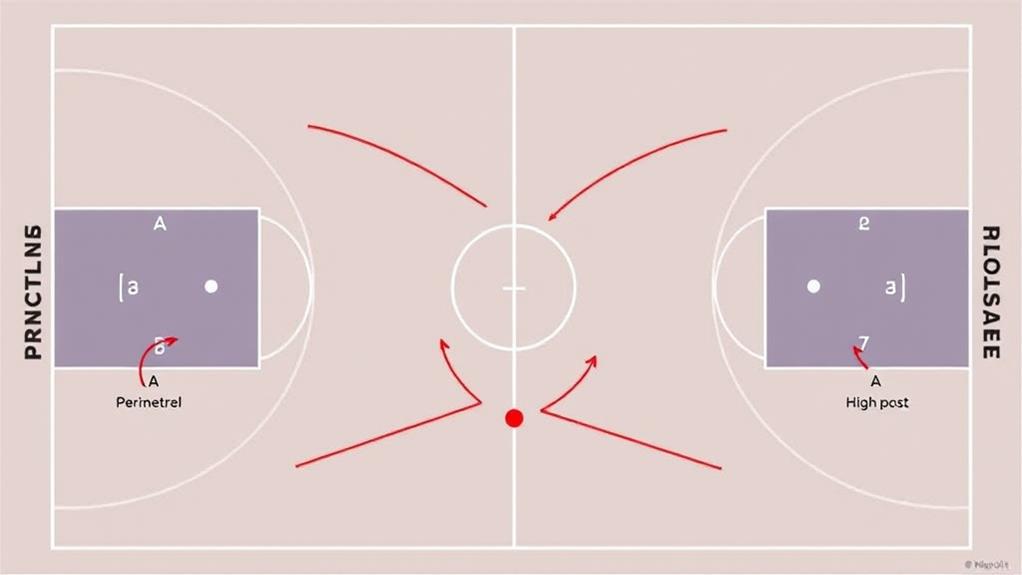
The Princeton Offense sets the stage for dynamic basketball play with its distinctive 2-guard front formation. In this setup, two guards position themselves near the slot areas, while two wings and one player occupy either the high or low post. This arrangement creates a balanced formation that encourages fluid movement and teamwork.
To maximize the effectiveness of this offense, it's beneficial to incorporate efficient play creation strategies that focus on high-percentage shots. Proper spacing is essential for the success of this offense. Players should maintain a distance of 12 to 15 feet apart, allowing for effective driving lanes and open passing options.
As the offense unfolds, continuous ball movement becomes critical, with players engaging in passing, cutting, and screening actions. This creates high-percentage shot opportunities, making it necessary for players to read defenses and recognize scoring chances.
The initial action typically starts with a high post entry pass, which triggers the movement of players. Utilizing screens effectively can facilitate scoring options, whether near the basket or on the perimeter.
Series and Play Options
Implementing series and play options in the Princeton Offense is vital for maximizing scoring opportunities. Each series creates dynamic movement, allowing your players to exploit defenses effectively.
Given the historical context of basketball, it's important to recognize that systemic barriers for Black athletes may influence how talent is evaluated and utilized within these series.
Here are four key series and their options to evaluate:
- Chin Series: Initiate with a dribble handoff (DHO) that sparks movement. This series opens up options for back screens, catch-and-shoot opportunities, or driving lanes based on the defense's reaction.
- Point Series: Focus on split-action plays emphasizing backdoor cuts. This series generates layups and perimeter shots, giving your players versatility and the ability to capitalize on defensive overplays.
- Low Series: Start with the ball in the low post. Utilize strategic cuts and screens to create high-percentage shot opportunities. This approach encourages teamwork and fluidity among your players.
- Counter Options: Each series includes various counters, allowing you to adjust strategies based on defensive alignments and player strengths. This adaptability is vital for maintaining offensive pressure.
Spacing and Movement Techniques
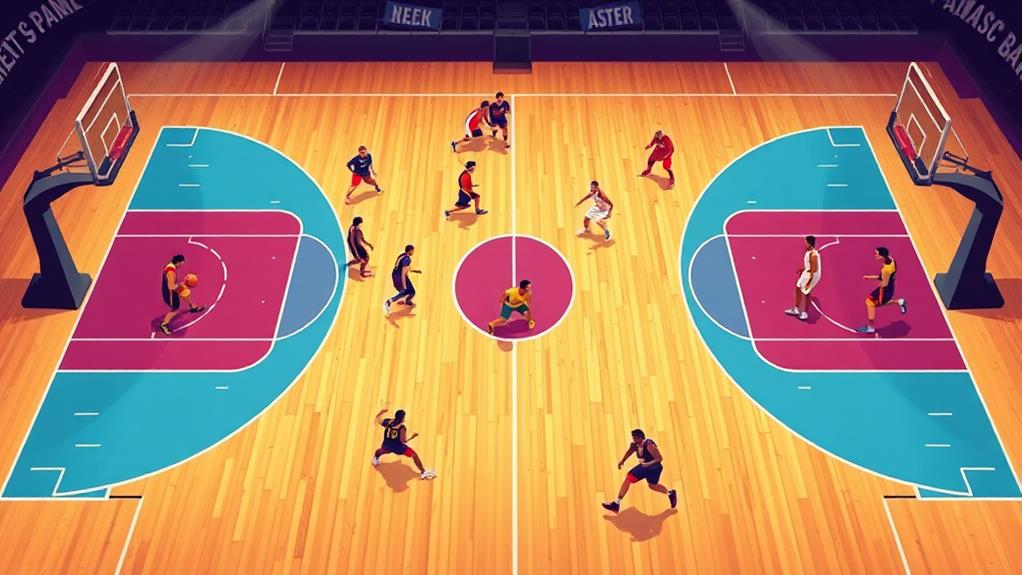
Creating proper spacing and employing effective movement techniques are vital for the success of the Princeton Offense. Position your guards about 3 feet above the 3-point line and your wings at the free-throw line extended, ensuring players are 12 to 15 feet apart. This spacing creates driving lanes and opens up passing options. Place your 5-man on the ball-side elbow to optimize ball movement and create opportunities for quick shots and cuts.
Constant movement is key. After passing, make sure to cut to an open space, ready to receive the ball. This eliminates help-side defense and generates open scoring chances. Incorporate the "Pass-Pass-Throw It" concept to encourage quick passes and screens. This strategy opens up options for backdoor layups, flare screens for 3-pointers, and elbow jumper opportunities.
Effective communication among players is essential. Be aware of your spacing and recognize when to cut or set a screen. Maintaining fluidity in your offense keeps defenders guessing, increasing your chances of scoring.
Drills for Effective Implementation
Effective execution of the Princeton Offense hinges on mastering specific drills that reinforce key concepts and player movements. By focusing on these drills, you can enhance your team's understanding and execution of the offense:
- Backdoor Cut Drills: Implement drills such as Backdoor Cut Top, Wing, and Corner to teach players effective cuts, ensuring they maintain proper spacing and timing for scoring opportunities.
- Screening Actions: Use drills that emphasize back screens and dribble handoffs. This helps players create open shots through effective screen setting, improving teamwork and fluidity.
- High Post Entry Drills: Focus on high post entries, incorporating pin down screens and movement patterns. This approach leads to high-percentage shot opportunities near the basket.
- Chin Series Drills: Practice the Chin Series with structured drills involving dribble handoffs and player interchange. This reinforces the continuity and teamwork essential for executing the Princeton Offense.
Start these drills without defenders to emphasize fundamentals, gradually introducing defensive pressure to challenge players' decision-making skills.
Conclusion
Incorporating the Princeton Offense can transform your team's playstyle, enhancing ball movement and creating open shot opportunities. Remember the case of the 1996-97 Princeton Tigers, who upset higher-seeded teams in the NCAA tournament using this strategy. By prioritizing teamwork, spacing, and intelligent movement, you'll develop a cohesive unit capable of outsmarting opponents. Stay committed to the fundamentals, and watch your game evolve as players embrace the art of the Princeton Offense.


